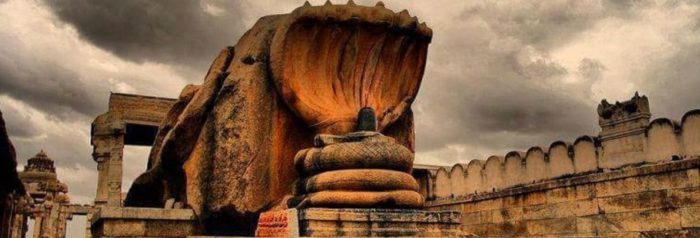
Shiva-lingam, India’s most emblematic hindu representation
The Shiva-lingam, or simply the lingam, is an enduring emblem of the Hindu faith in India. Several theories exist to explain the origin of this ancient and emblematic representation, but many share common ground in the belief it relates to fertility cults of aeons past. This is largely down to the phallic shape it’s synonymous with. However, it would be wrong to relegate the Shiva lingam to something so simplistic and purely sexual in nature. In fact, the word ‘lingam’ is Sanskrit in origin and means ‘ symbol’ or ‘sign’. As such, we can take the literal meaning as the ‘sign of Shiva’ or ‘Shiva’s sign’. In short, it is an emblematic form of Shiva. It is a representation of the divine without body, the origin of all things.
Cosmic Eggs & Birth of the Universe
The original form of the Shiva lingam was an egg-shaped one, at least according to the Brahmanda Purana, a key Sanskrit text. This egg-shaped form represented the universe itself. The word ‘Brahmanda’ itself means ‘cosmic egg’, with the first half of the Sanskrit word meaning ‘cosmos’ and the latter half meaning ‘egg’.
Additionally, amongst the founding texts of the Hindu faith, passages mention Hiranyagarbha, which broadly translates as ‘golden belly’ or ‘golden foetus’. In these ancient scriptures, it is told that the Hiranyagarbha was adrift in an empty void for a certain time, before it separated into two to form the sky and the earth. As such, the Hiranyagarbha is seen to have given birth to the universe itself and everything within it.
The concept of a cosmic egg, otherwise known as a ‘world egg’ or ‘mundane egg’, is a staple of many civilizations across the planet. Greek, Egyptian, Norse and Phoenician mythologies are just a few to share common motifs of the cosmic egg with Vedic mythology.
An Emblem of Complementary Energies
You’ll find some lingams inserted into a larger cylinder-shaped base referred to as a yori. This means ‘vagina’ in Sanskrit. These particular lingams, or ‘lingam-yoris’, are a clear representation of the coming together of two halves. In particular, the male half and female half of a whole.
A less obvious connotation of the Shiva lingam is the coming together of active energy and consciousness. When you approach it from this angle, yori is instead referring to a primordial energy force (commonly referred to as ‘Shakti’ or ‘Devi’) that ultimately will unite with the Divine Consciousness itself.
A further interpretation is that yori is the Earth, moving around lingam, the sun. The sun then moves around other stars, with the result being the creation of its own yori. This pattern then repeats and radiates out into infinity.
The Trimurti
Another interesting perspective to consider is the Trimurti. This refers to the three individual parts that make up the Shiva lingam. Shiva, Vishnu and Bhrahma are all represented, with the base component of the lingam, the so-called ‘Brahma-Peetha’, said to represent the very beginning of the universe itself at the moment of its creation. The middle component, the Vishnu-Peetha, is symbolic of the preservation of said creation. The final, uppermost component is the Shiva-Peetha. This final tier represents destruction.
An Infinite Pillar of Light
The lingam is referred to as a pillar of light that has no discernible top or base, according to the Shiva Purana. Jyotir lingams refer to any lingams that specifically symbolize this pillar of light motif. All in all, there are a dozen of these scattered across India. Amongst the various Shiva lingams, these are prized as the most sacred.
Swayambhu Lingams
While lingams created by individuals are referred to as Manusi lingams, Swayambhu lingams refers to naturally created ones. In most cases, these naturally occurring lingams are stones bearing an oval form. The most impressive of these are left where they are, with temples and places of worship sometimes erected around them. A specific type of naturally occurring lingams are called ‘Banalingams’. Found at the bottom of the River Narmada, these lingams are stones, naturally shaped by the water of the river itself. Many consider these stones to be sacred items, while others believe them to have innate mystic properties.
The Five Elements
In various places, five individual Shiva lingams are used to represent each of the five main elements found in nature. These elements are ether, fire, earth, water and air. Together, they are referred to as ‘Pancha Bhoota Sthalas’. Roughly translated, this means “Five elements place”. Four of these lingams (earth, water, fire, ether) can be found at various temples in Tamil Nadu. The fifth element, air, is represented at the Sri Kalahasti Temple in Andhra Pradesh.
